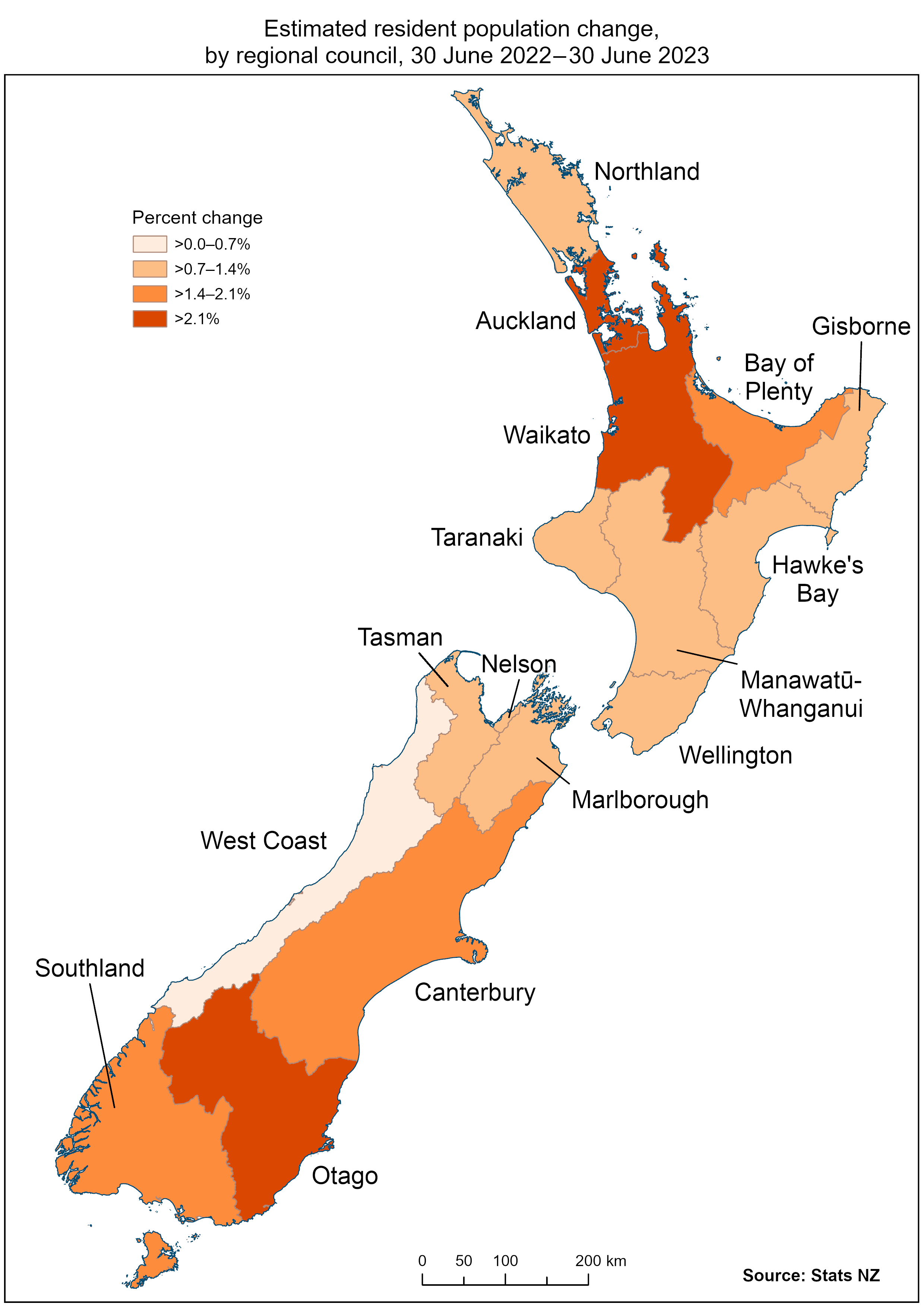The population grew in all 16 regions of New Zealand in the year ended June 2023, according to provisional estimates released by Stats NZ today.
This follows two years of lower growth when several regions decreased in population.
"Auckland was the fastest growing region in 2023, reversing a population loss in 2022," estimates and projections manager Michael MacAskill said.
Auckland grew by 47,000 people, or by 2.8 percent, in the year ended June 2023.
"Otago, Waikato, and Bay of Plenty regions also grew faster than the New Zealand average," MacAskill said.
Nationally, the population grew by 2.1 percent (105,900 people) in the year ended June 2023, a significant increase from the growth of 0.1 percent in the previous year (5,800 people).

Migration drives population change
Net migration was the main contributor (78 percent) to Auckland's growth with the remainder attributed to natural increase (births minus deaths).
Net migration for subnational areas includes internal migration (people migrating within New Zealand) and international migration (people migrating between New Zealand and other countries).
"Auckland gained people through international migration, but lost people through internal migration, continuing the pattern since the late 1990s," MacAskill said.
Otago's high growth rate (2.7 percent) was driven by population growth in Queenstown-Lakes district, New Zealand's fastest-growing territorial authority area over the year.
Queenstown-Lakes grew by 8.0 percent (or 3,900 people) in the year ended June 2023, following lower growth in 2022 (1.5 percent). This growth was driven by a net international migration gain of 2,500 people, with net internal migration (1,100) and natural increase (340) making smaller contributions.
Other territorial authority areas growing faster than the New Zealand average include Selwyn district (5.2 percent), Mackenzie district (3.6 percent), Hamilton city (3.4 percent), Auckland and Western Bay of Plenty district (both 2.8 percent), Waikato and Central Otago districts (both 2.6 percent), Tauranga city (2.5 percent), and Waimakariri district (2.2 percent).
These areas all had population gains through net international migration and natural increase, and all but Auckland and Hamilton city had gains through net internal migration.
Record number of areas with natural decrease
"A record 16 out of 67 territorial authority areas experienced natural decrease, or more deaths than births, in the year ended June 2023," MacAskill said.
The areas with the largest natural decreases included Dunedin city (190 more deaths than births), Thames-Coromandel district (170 more), Kapiti Coast district (160 more), Nelson city (100 more), Whanganui district (90 more), and Timaru district (80 more).
All territorial authority areas with natural decrease, apart from Buller district, still had population growth in the year ended June 2023 due to net migration gains exceeding the natural decrease.
Revisions and 2023 Census
New Zealand's net international migration in the years ended June 2022 and 2023 was provisionally estimated at -17,600 and +86,800, respectively (consistent with the National population estimates: At 30 June 2023 published in mid-August). These international migration estimates differ slightly from the latest available international migration estimates, which are revised monthly.
Estimates after 30 June 2018 are based on results from the 2018 Census updated for births, deaths, and migration. The estimates are subject to revision after results from the 2023 Census and 2023 Post-enumeration Survey are available.
Text alternative for map Estimated resident population change, by regional council, 30 June 2022-30 June 2023
Estimated resident population change, by regional councils, 30 June 2022-30 June 2023. The map shows the regional council areas, each assigned a colour to show the range of change in the estimated resident population in the year ended 30 June 2023. The colours are grouped into annual percent change 2022-2023 of: greater than zero to 0.7 percent; greater than 0.7 to 1.4 percent; greater than 1.4 to 2.1 percent; greater than 2.1 percent. The annual change ranged from a 2.8-percent increase in the Auckland region to a 0.4-percent increase in the West Coast region.
Subnational population estimates (RC, SA2), by age and sex, at 30 June 1996-2022 (2023 boundaries) has more data.






